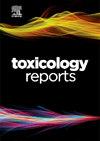单异戊基2,3-二巯基琥珀酸负载纳米颗粒通过抑制SH-SY5Y细胞的线粒体自噬和减少氧化应激来调节铜诱导的神经毒性。
Q1 Environmental Science
引用次数: 0
摘要
铜(Cu2 +)失调,通常源于ATP7B基因突变,加剧神经系统疾病,如亨廷顿病,阿尔茨海默病和帕金森病。单异戊基2,3-二巯基琥珀酸(MiADMSA)通过螯合细胞内Cu2+离子、减少氧化应激和恢复抗氧化酶功能,有望减轻Cu2+诱导的神经毒性。然而,生物利用度差等挑战阻碍了其治疗效果。纳米递送系统通过改善MiADMSA的溶解度、稳定性和靶向递送提供了一种解决方案,潜在地减少了脱靶效应。本研究采用凝聚交联的方法将MiADMSA加载到与硫辛酸(LA)和人血清白蛋白(HSA)偶联的聚合物中。采用Box-Behnken设计对制备的纳米颗粒进行优化。在SH-SY5Y细胞中的评估显示,对Cu2+诱导的神经毒性有良好的神经保护作用,突出了负载miadmsa的纳米载体作为与金属失调相关的神经退行性疾病的治疗策略的潜力。本文章由计算机程序翻译,如有差异,请以英文原文为准。
Modulation of copper-induced neurotoxicity by monoisoamyl 2,3-dimercaptosuccinic acid loaded nanoparticles through inhibition of mitophagy and reduction of oxidative stress in SH-SY5Y cells
Copper (Cu2 +) dysregulation, often stemming from ATP7B gene mutations, exacerbates neurological disorders like Huntington’s, Alzheimer’s, and Parkinson's diseases. Monoisoamyl 2,3-dimercaptosuccinic acid (MiADMSA) shows promise in mitigating Cu2+ induced neurotoxicity by chelating intracellular Cu2+ ions, reducing oxidative stress, and restoring antioxidant enzyme function. However, challenges such as poor bioavailability hinder its therapeutic efficacy. Nano-delivery systems offer a solution by improving MiADMSA's solubility, stability, and targeted delivery, potentially minimizing off-target effects. In this study, MiADMSA was loaded into a polymer conjugated with lipoic acid (LA) and human serum albumin (HSA) using a coacervation crosslinking method. The prepared nanoparticles were optimized using a Box-Behnken design. Evaluation in SH-SY5Y cells revealed promising neuroprotective effects against Cu2+ induced neurotoxicity, highlighting the potential of MiADMSA-loaded nanocarriers as a therapeutic strategy for neurodegenerative diseases associated with metal dysregulation.
求助全文
通过发布文献求助,成功后即可免费获取论文全文。
去求助
来源期刊

Toxicology Reports
Environmental Science-Health, Toxicology and Mutagenesis
CiteScore
7.60
自引率
0.00%
发文量
228
审稿时长
11 weeks
 求助内容:
求助内容: 应助结果提醒方式:
应助结果提醒方式:


